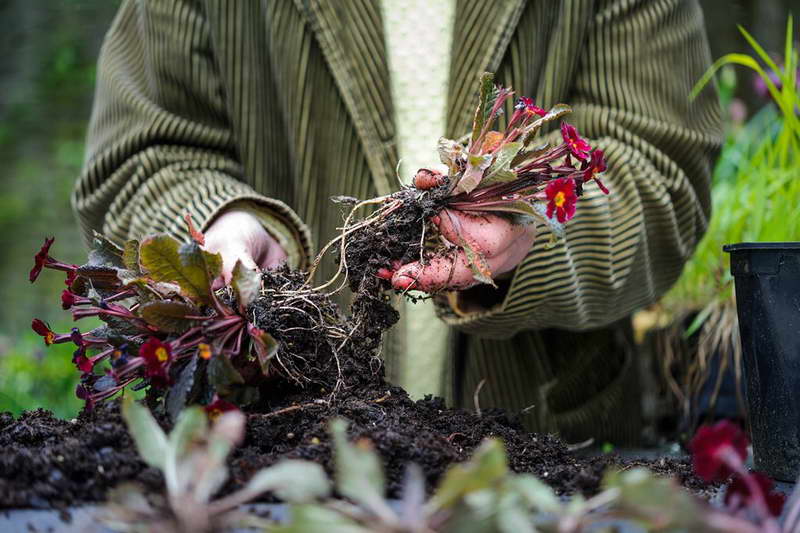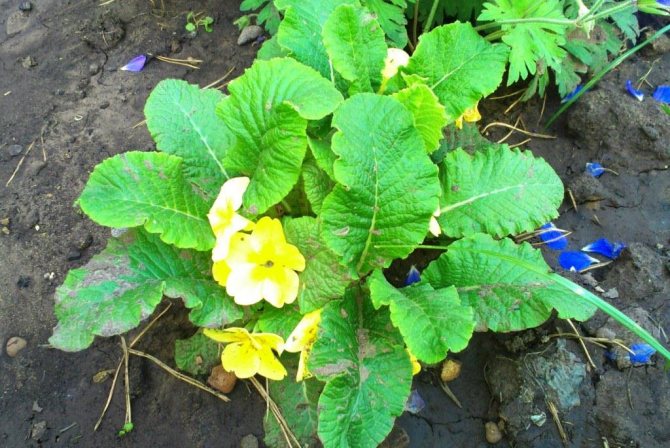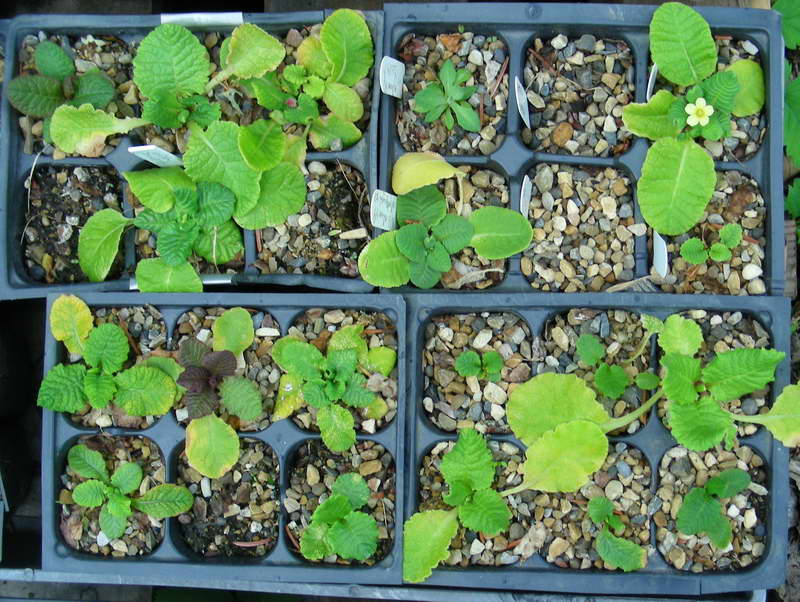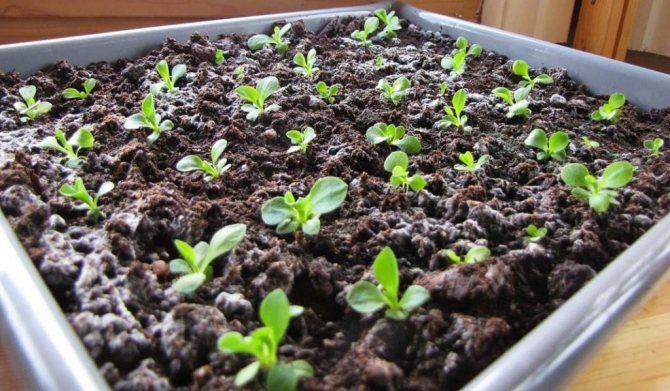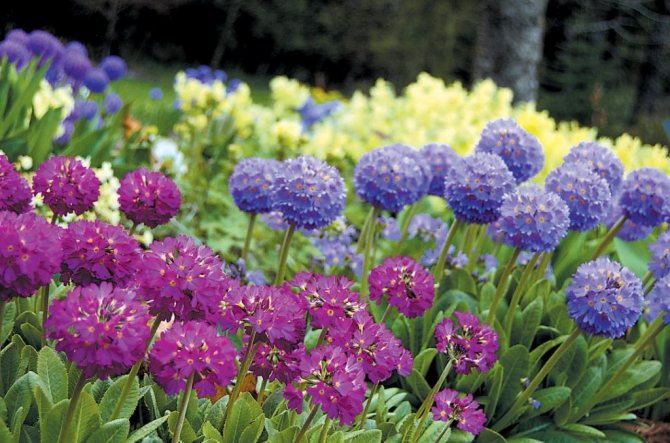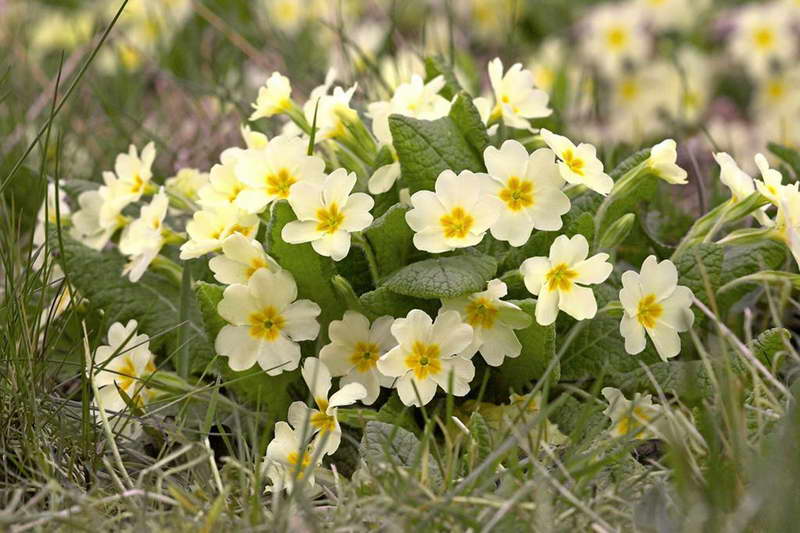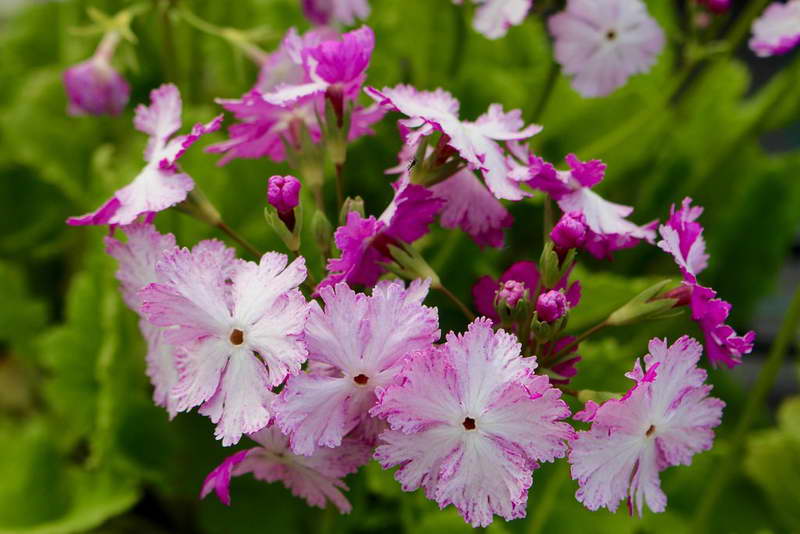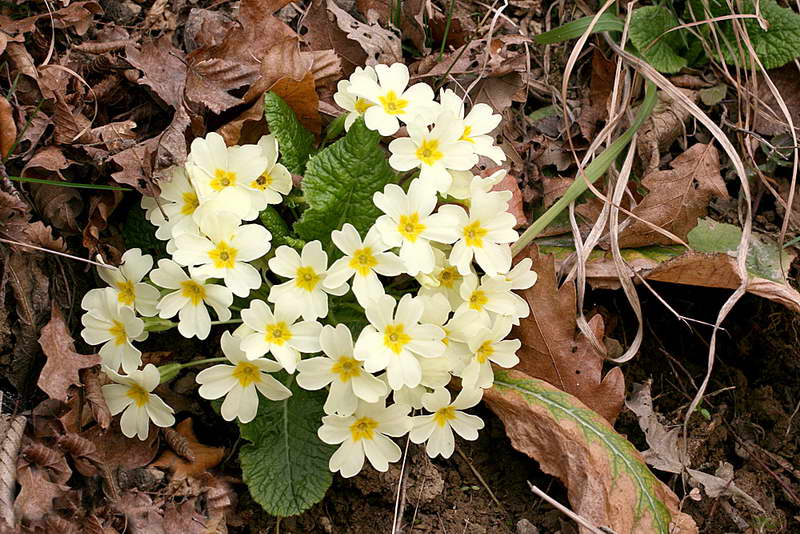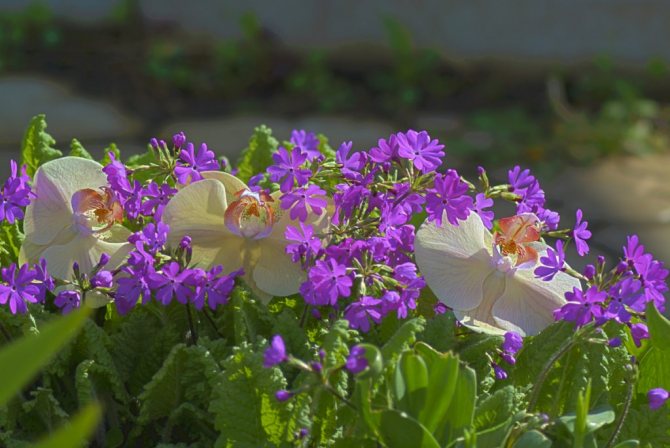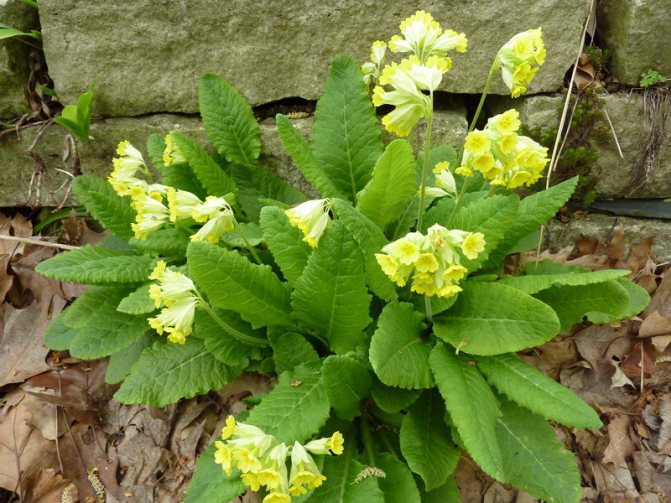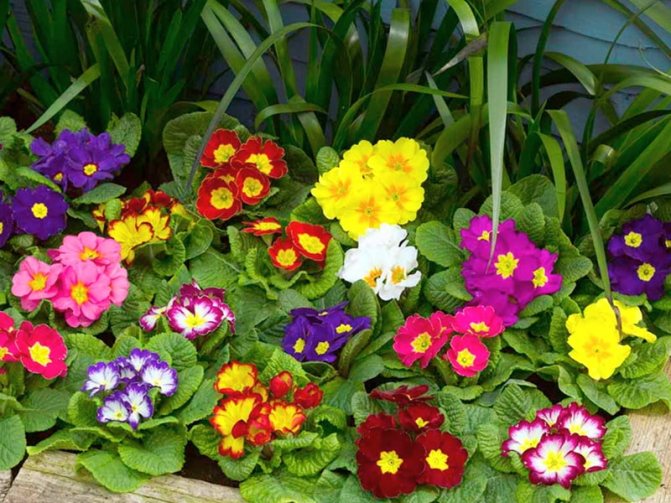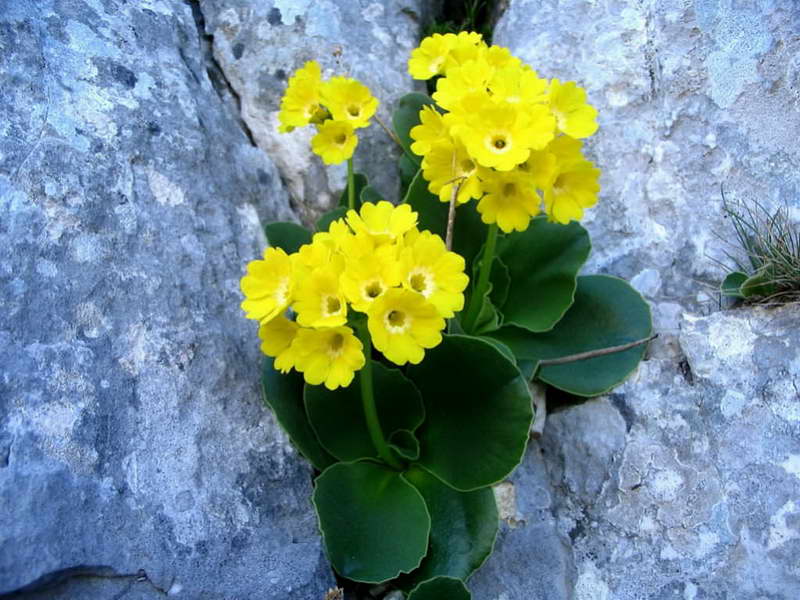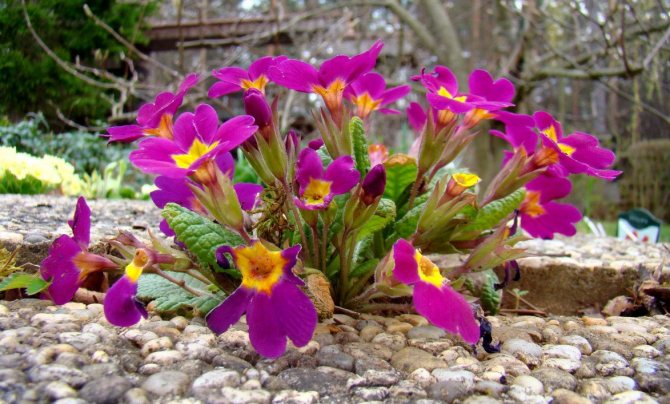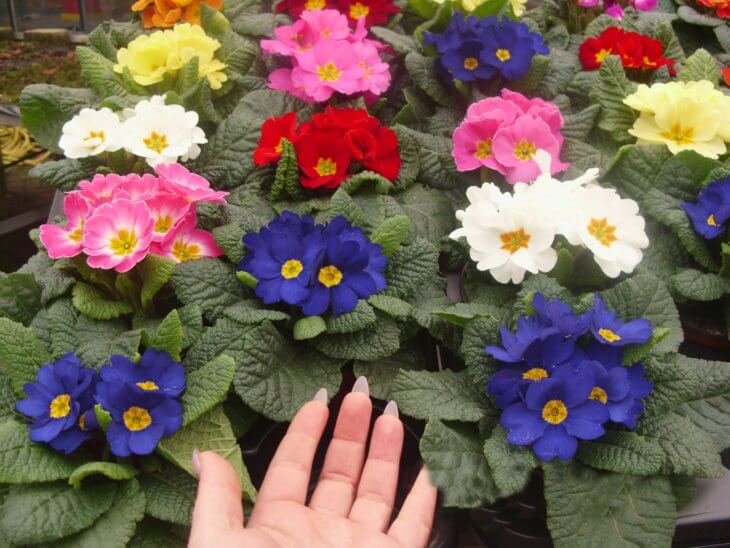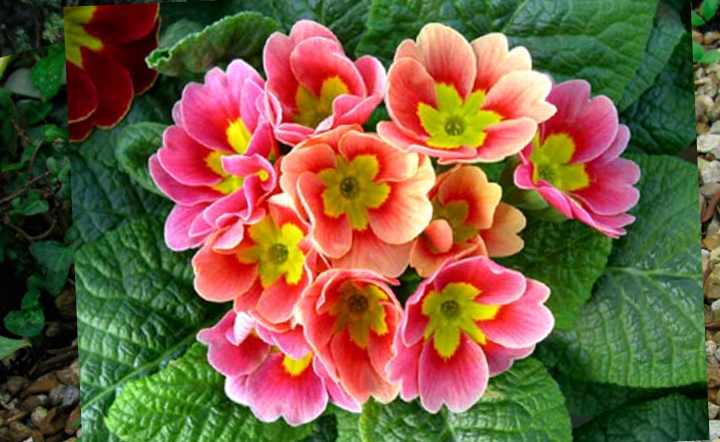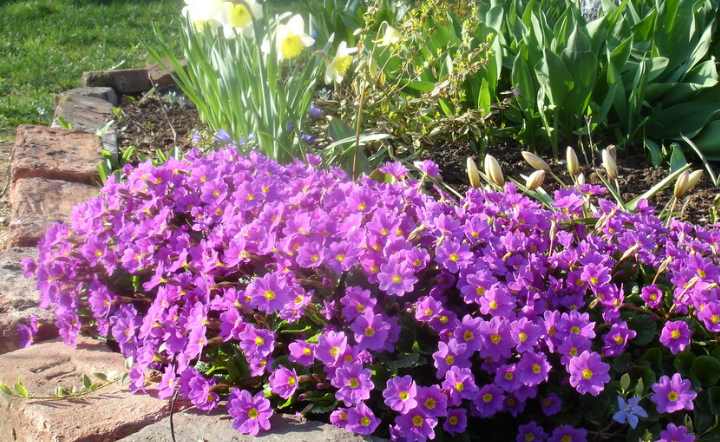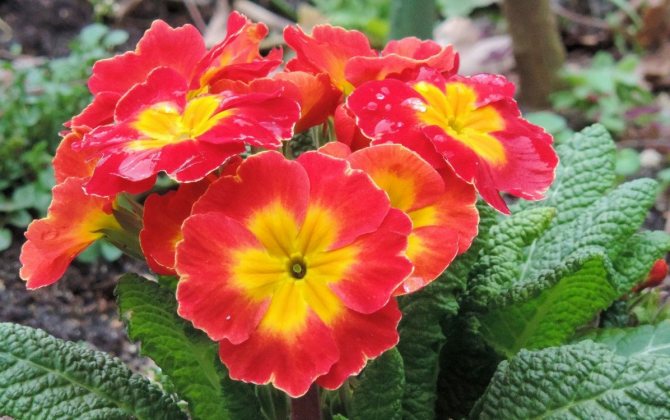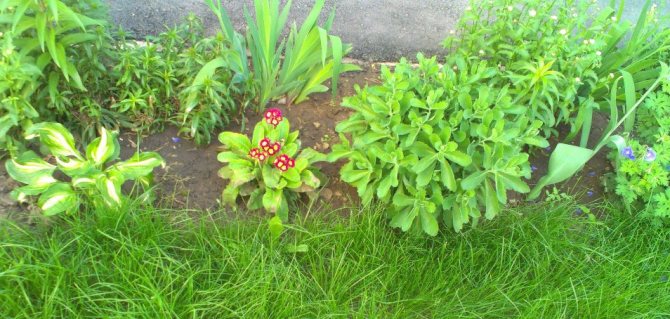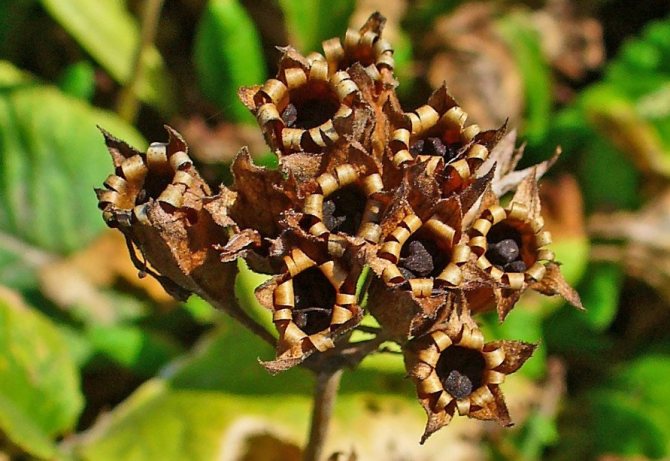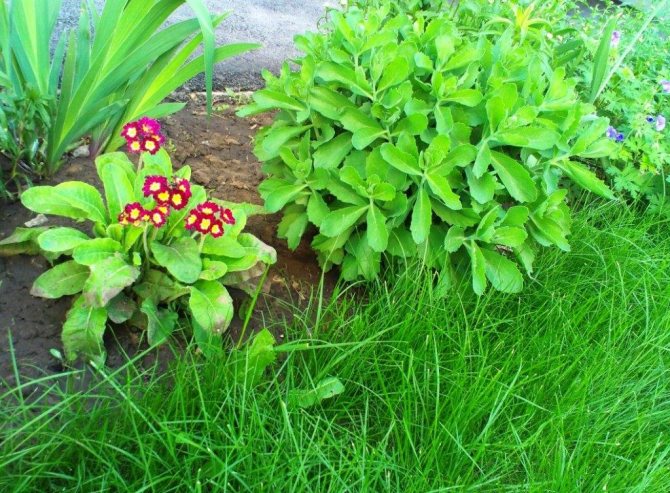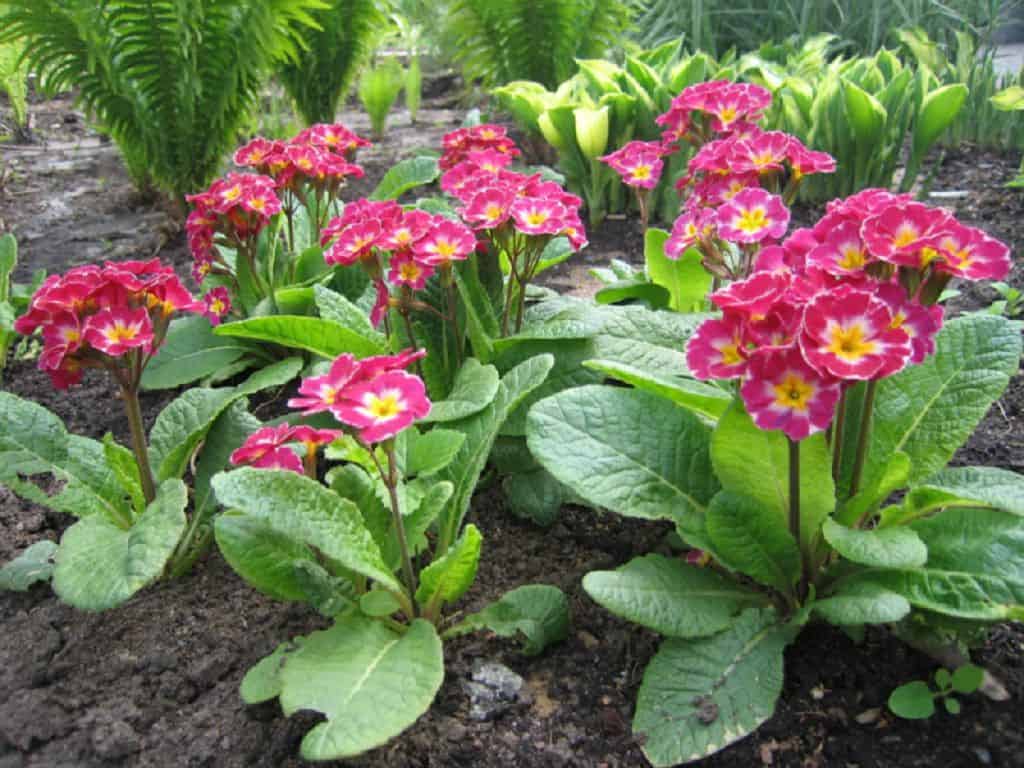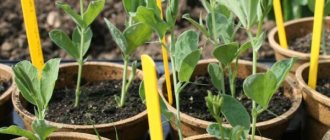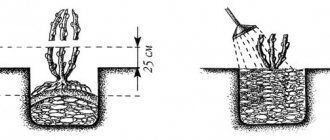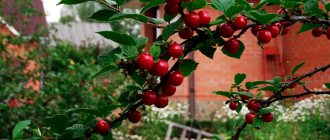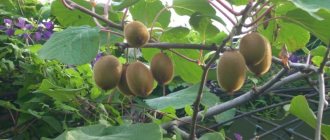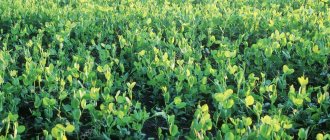I have been growing primrose for a long time. Propagated in different ways, of which there are at least 3: dividing the bush, seeds and leafy cuttings (or leaves). I have already used the first two methods, but I have not reproduced the sheets yet. I had one favorite variety to propagate, and the flower had a very weak root system. Therefore, only one method of reproduction appeared to be possible - cuttings. I decided to share my experience and impressions of how to carry out this process correctly, as there are some peculiarities.
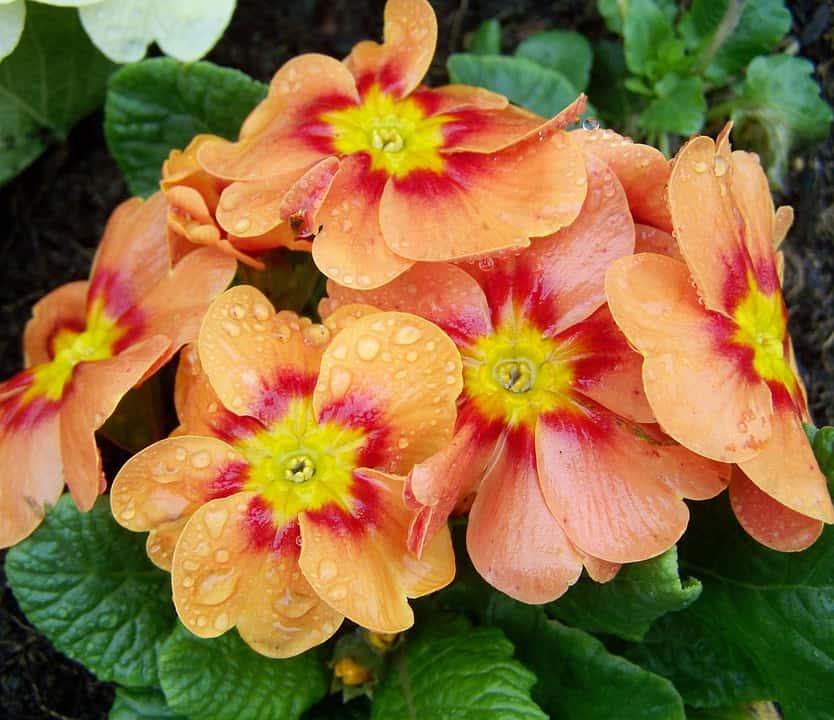
When is the best time to transplant a flower, in spring or autumn?
First of all, the transplantation time depends on the type and variety of primrose.
- Species that have two phases of active growth and bloom twice a season are transplanted after flowering ends in spring or autumn.
- Primroses, which bloom once, in April-May, are recommended to be replanted in early autumn, when the plant awakens. This period is good for transplanting a plant so that the primrose has gained strength and can perfectly adapt to new conditions for it.
We talked in detail about the intricacies of caring for primrose and plant transplanting in autumn here.
Common primrose
Common primrose or stemless primrose is a perennial plant, the homeland of which can be considered South and Central Europe, the Crimea, the Caucasus. It grows everywhere in the temperate climatic zone, and blooms one of the first, almost immediately after the spring melting of snow.
Therefore, the people often call this flower a primrose. And its Latin name Primula comes from the word primus - the first.
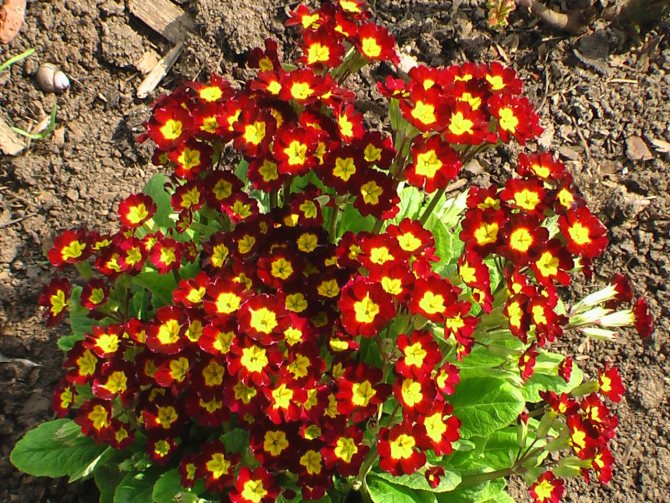

The grass may not be there yet, but the primrose is already blooming
Many summer residents grow stemless primrose in the garden, in the open field, as a perennial plant. But no matter how early it was, the first flowers in the middle lane should not be expected before April, or even May.
If you take care of growing seedlings in a greenhouse, starting in mid-summer, flowering bushes can be obtained by the New Year, and by March 8, and by other winter and early spring holidays. At this time of the year, fresh flowers are especially appreciated, and a bright and lush primrose in a pot or a beautiful planter is in no way inferior to bouquets of cut roses or tulips (see Growing tulips in a greenhouse: how to do it right).
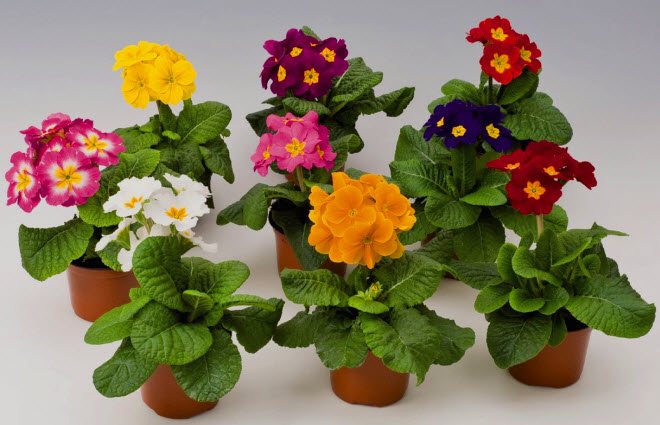

Hybrid varieties of primroses differ from traditional varieties by their unusual color and size of flowers.
It blooms for at least 2-3 weeks, and if it is kept cool, even longer.
The advantage of hybrid varieties is that stratification is not required for their cultivation - hardening of seeds, which is necessary for garden primroses. They are immediately planted in the ground, germinated, dived, and after 5-7 months from the day of sowing, they get a blooming miracle.
See for yourself: they really are extraordinarily beautiful:
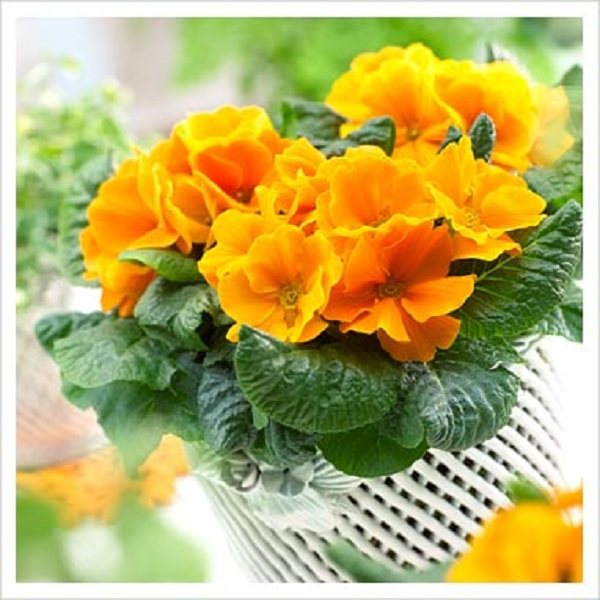

Salome orange sun


Sphinx F1 Rose Shades
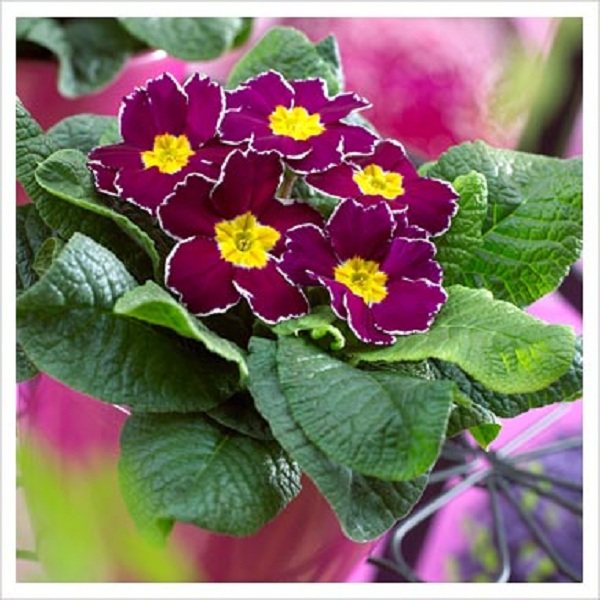

Eclipse violet with rim
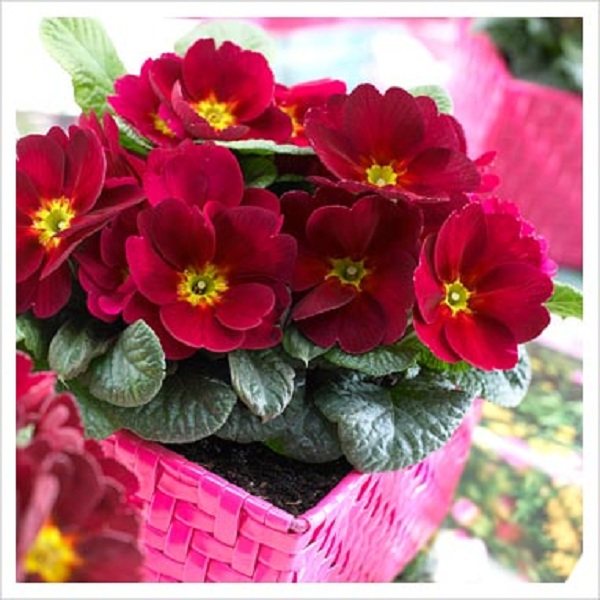

Sphinx F1 Neon Rose
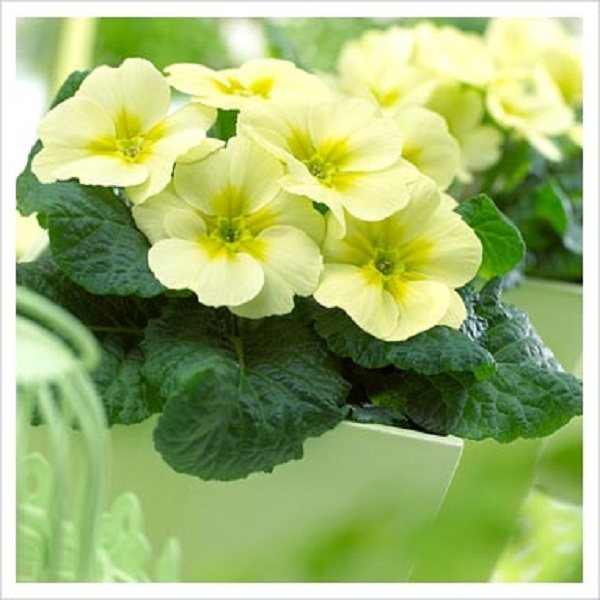

Lime Green


Sphinx F1 Real Orange
Advice. When the plants have faded and it is warm enough outside, they can be transplanted into open ground. There is a chance that they will take root, and will bloom in the spring for more than one year.
When to transplant and divide?
Important! The flower requires a transplant once every 3-4 years. Do not do it more often.
Before you start planting your garden primrose, make sure of the following:
- The bushes have grown very much, and the rosettes have become cramped.
- Flowering is no longer lush and lasts less time.
- The roots are bare, and this is a risk, because the plant can die from the cold.
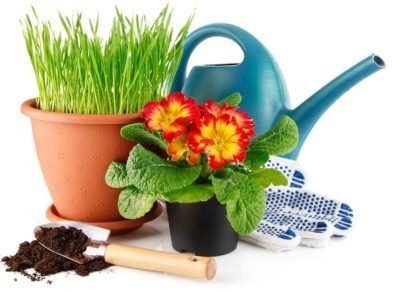

If at least one of these signs was noticed, then the primrose definitely needs a transplant.
- Lighting... Both at home and in the garden, it is necessary to choose the brightest place for the primrose.
But do not forget that the plant should not be exposed to direct sunlight. The light should be diffused. The ideal place for primroses would be the west or east side. - Soil and fertilizers... The potting mix is made from sand, peat and turf, which are mixed in equal proportions. Sometimes flower growers buy a ready-made substrate and add 20% sandstone to it, but this is done only if the plant is at home.
Immediately after the primrose is transplanted in the garden, it does not need feeding. It will be needed a few months later, when the flower takes root in a new place. It is best to do natural feeding, chicken droppings are well suited. It is diluted 1:15, but no more. Fertilizer should be applied once every few weeks. - Watering... Proper watering is very important for primrose. She does not like excessive soil moisture. The main thing is to wait for the topsoil to dry completely between waterings. In no case, during the procedure, do not get water on the plant itself.
- Humidity... Humid air is beneficial for a flower, especially after transplanting. On hot days, primrose is lightly sprayed or a container of water is placed close to give moisture.
There is no need to overdo it with watering, otherwise a lot of moisture will lead to rotting of the roots. - Temperature... The high temperature is not suitable for the flower. In order for the plant to root faster and get used to a new place, it is worth maintaining the temperature around + 13 + 15 degrees. Only one of the species will not take root if the temperature is below +16 .. + 18 degrees - reverse conical.
Video instruction for transplanting a flower:
Plant features
The desire to grow primrose is widespread in two cases: for the sake of obtaining a beautiful flowering and the production of essential oils, which are widespread in the preparation of medicines for the prevention of colds.
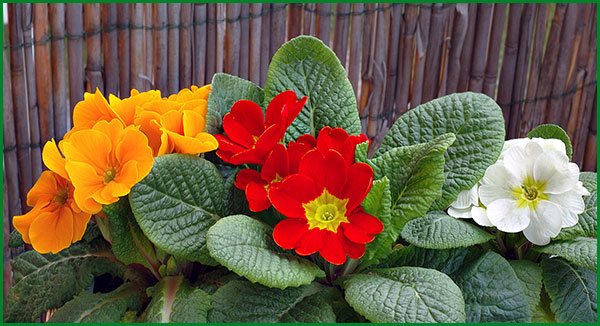

Multicolored primrose bloom
In order for a blooming primrose to please the eye for a long time, it is necessary to know several features of its development and ideal care.
Herbs are distinguished by pink, red, yellow, occasionally lilac flowering. The buds periodically grow singly, but for the most part they gather in umbrella constellations on tall and strong stems. The flowers are very large, with a strong pleasant scent. Unlike many other flowering plants, the color of the petal is more intense at the edges than that of the receptacle.
Reference. Many growers are upset by the fact that it is not always possible to grow primrose of different colors in one planting, since with the same care, the color of different bushes is most often identical.
How to care for an established plant in the garden?
There should be no problems with transplanting garden primrose. The flower is quickly accepted and after a while begins to delight with its beautiful flowering. But it must be remembered that the soil in the area where the primrose grows must be loose and moist.
To stimulate the activity of the flower in the winter, watering after transplantation is gradually increased.
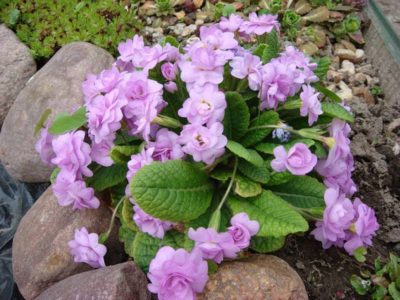

Rules for caring for a transplanted primrose:
- Proper watering must be observed. The soil should be moist, but in moderation.
- In the last days of autumn, to prepare the primrose for winter, gardeners fertilize the plant with manure.
- Before covering a flower with foliage for the winter, it is worth examining the root system. If the roots are bare, then they are first covered with earth, and then leaves are raked up from above.
- Necessarily, after a couple of weeks, the plant must be weeded. This is done so that gray rot does not develop.
You can learn about the rules for caring for primrose in the garden and at home from our article.
Our experts have prepared for you other useful materials about the peculiarities of planting and growing perennial primrose, as well as breeding a plant from seeds.
Primrose at a glance
Before we start discussing the main topic, let's consider what a primrose is. Let's dwell on the structure. The flower is considered a primrose, and for many years it has been successfully grown by flower growers in a flower bed and as an indoor flower.
Morphological signs
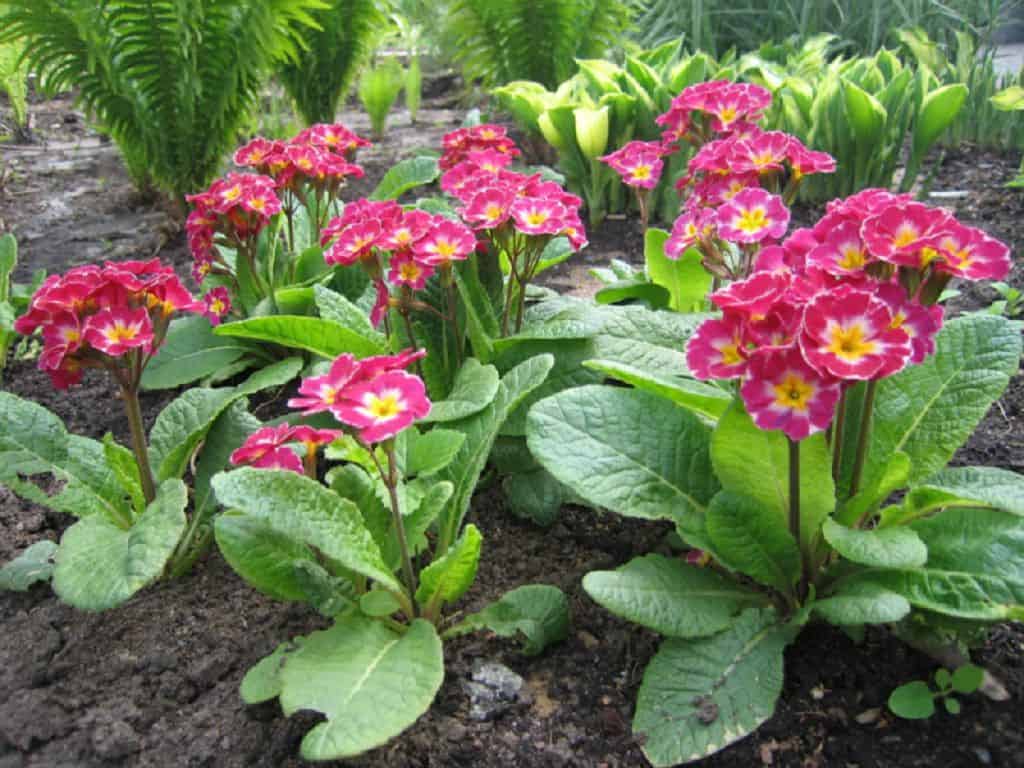

- The flower is small enough, stretching no more than 15 - 35 cm. It grows quickly enough, and has a branched and well-developed root system. The roots are superficial and fibrous.
- The stem of this primrose is quite short, strong and fleshy, and the leaf plates have a rich dark green hue.
- Depending on the variety, the leaves are heart-shaped or elongated. The leaf surface is usually wrinkled, not smooth, and covered with small villi.
- Flowering is represented by small bright flowers, located on elongated petioles. They form a neat rosette. The bush is compact and symmetrical.
- The shape of the flower is quite original, reminiscent of a gramophone. The flower has 5 petals, and the upper part of each is divided into several lobes (usually 3).
- The color scheme is very diverse. We can find contrasting combinations of almost all colors of the rainbow. There are also monochromatic flowers, two-colored, with bright edging.
- During the flowering period, the bush is covered with a large number of buds and already opened flowers. In the central part of the rosette, a "bouquet" is formed, consisting of different types of inflorescences: capitate, whorled, racemose and umbellate.
Useful primrose
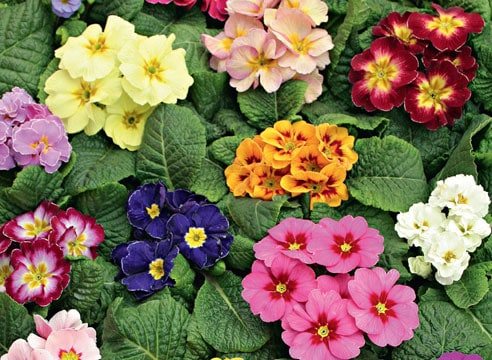

Many people know that the plant has many beneficial properties and can heal various ailments. Primrose leaves are used to make salads. However, it should be borne in mind that some varieties of primrose are poisonous and are not recommended for growing for people with allergies.
All parts of the flower are useful. They can cure many diseases of the respiratory system, such as bronchitis. It is also a storehouse of vitamins, also includes carotene, ascorbic acid, and in the root system we can find essential oils. Decoctions from primrose can not only cure diseases of the upper respiratory tract, but also relieve insomnia, and have a sedative effect.
Possible diseases and treatment
Often, a plant that has been transplanted dies from a disease called peronosporosis. The people also call it downy mildew. This disease damages shoots, leaves, peduncle. The disease is absolutely not afraid of frost. In winter, it is found in fallen leaves, roots and seeds.
The most important thing is to notice the disease in time.... It manifests itself with the following symptoms:
- Shapeless spots appeared on the leaves. They are yellow, pale yellow, red-brown.
- As the disease progresses, the leaves will begin to wilt and turn brown.
- The places that were hit will eventually merge together.
- A whitish bloom has appeared at the bottom of the leaf.
So that the plant does not get sick with peronosporosis, after transplanting it is recommended to weed the area... It is also necessary to abandon fertilizers containing nitrogen and destroy all weeds. If the gardener himself cannot cope with the disease, then he needs to buy biological preparations - "Fitosporin" or "Alirin".
Another disease affecting primrose is ramulariasis. Large spots of round yellow color are a clear sign of this disease. As the disease develops, the spots change their colors, and eventually holes appear in their place. Ramulariasis occurs in cool and overly humid conditions in which the flower is kept.
To prevent primrose from becoming a victim of this disease, it must be properly watered and loosened in a timely manner. If ramulariasis has been noticed, action must be taken immediately. The first step is to remove all affected areas of the plant. Then it is already possible to treat with fungicides - "Fundazol" or "Vitaros".
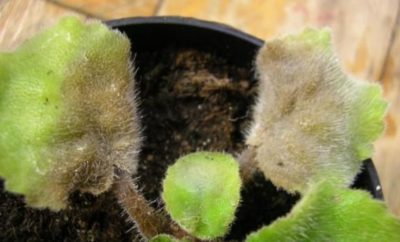

Also the flower often dies due to gray mold... It is caused by a fungus. At the time of growth, spots with a gray bloom appear on the peduncles and foliage. With a large area of damage, the primrose dies.
It will appear, gray rot may be due to poor ventilation, a small amount of light, or waterlogging of the earth. To overcome the disease, "Fundazol" is used, but the infected areas of the flower are removed first.
Description of primrose: what it looks like
The division of primrose bushes is carried out not only for the purpose of reproduction, but also to rejuvenate the plantings. Old bushes give poor flowering, suffer more from hot weather and are more exposed to freezing. To protect the rhizome of an adult plant, it is recommended to pour compost soil under the bushes every year at the end of the growing season.
The germination rate of primrose seeds drops rapidly after harvesting. So, during the period of winter storage at room temperature, germination decreases to 80-60%. Even when stored for less than a month, the seeds are strongly separated by germination energy, which leads to extended seedlings. Therefore, it is recommended to sow the seeds directly after collection in the ground with plots marking or in boxes in the open air.
- a hybrid of a tall primrose with a characteristic flower color: yellow center, red round petals with a bright yellow stripe along the edge.
Growing primrose from seeds for seedlings
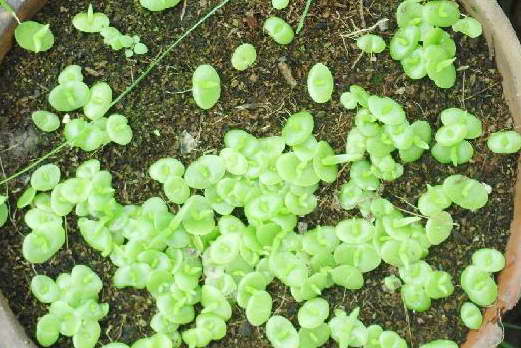

How to sow primrose seeds photo shoots
Primrose seeds do not last long, quickly losing germination. When purchasing a bag of seed, make sure it is harvested in the current year. To improve germination, natural stratification should be performed.
When should you sow primrose? Sowing begins already from the first days of February, given the long preparation and slow germination of seeds.
- Seedling boxes with loose nutritious soil are prepared; ready-made soil for flowering plants is excellent.
- Drainage holes must be made in the bottom of the box or container.
- Seeds are sown as rarely as possible on the surface of the earth, pressed with a palm, you can only lightly sprinkle it on top with sand, or you can not sprinkle it.
- Moisten with a spray gun, cover with a plastic bag.
- Stratification can be carried out directly on the street or on the balcony, where the temperature below zero should not fall below -10 ° C.
- After a month, the containers are brought into the room and thawed on the windowsill. It is advisable not to raise the temperature above 16-18 ° C so that the plants do not stretch out.
Stratification can be omitted only for two types of primrose: fine-toothed and ordinary, the rest must be frozen.
Forcing primroses
An important benefit of a primrose is that it can be grown by a specific date. The procedure for accelerating plant growth is called forcing.
For forcing choose undersized miniature varieties of primroses at the age of two to three years. Older plants are preliminarily divided into several parts. In November, the selected primroses are dug up and transferred with a clod of earth to a room where they are kept at a temperature of 3-4 ° C until February.
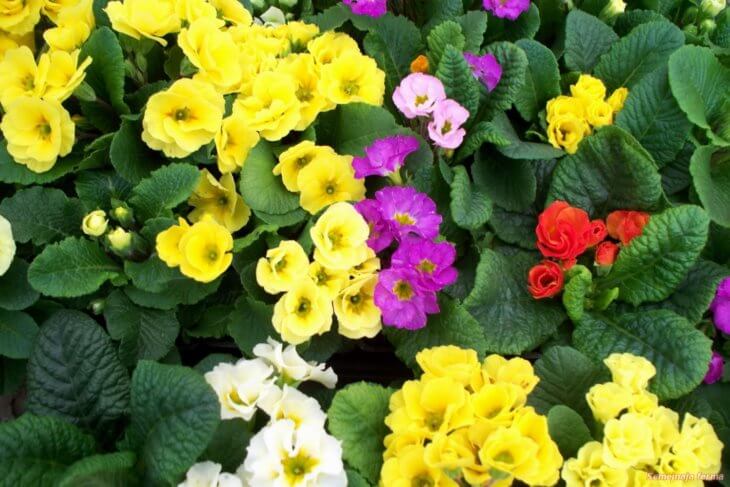

Primrose for landscape decoration
With the onset of February, the peduncles and leaves are removed from the plants and planted in containers with universal soil or a special substrate for primroses.
The bushes are grown in conditions of good light and humidity at a temperature of about 10 ° C heat. Top dressing with a weak solution of a complex mineral fertilizer is carried out once before the formation of ovaries.
In such extreme conditions, primrose blooms much faster. It is only important to choose healthy and strong specimens for distillation.
After the end of the flowering period, the plants can be planted outdoors and cared for as usual.
While watching the video, you will learn about growing a primrose.
Primrose, or in other words, primrose is a rather unpretentious plant. It will decorate both the personal plot and the windowsill in the living room.
In addition, these flowers can be grown to a specific date by forcing. All these facts are a good reason for breeding delicate spring primroses.
Attention super FLY!
Garden flowers
Interesting to read:
- Primrose high: description of the plant and its medicinal properties
- Perennial primrose: the main characteristics of growing from seeds
- How to grow primrose from seeds, as well as caring for it
- Cyclamen seed reproduction: variety selection, sowing secrets and keeping conditions
- Buttercup anemone: basic rules of maintenance and care
- How to grow mini cacti - features and rules of care
- What are mosses: names and characteristics
- How to grow a home flower spathiphyllum
- Tulip dynasty: the main features of this variety
Diseases and pests
Primrose has a fairly strong immunity to all kinds of diseases. However, some of them can still infect your plant.
Bordeaux liquid
The most unpleasant for primrose is the fungus Ramularia cercosporella. This disease can be recognized by the spots on the leaves of the plant. Most often they appear at the very end of spring. The spots that appear on the leaves have an angular or round shape and a pale color, but later they acquire a gray or brown color with a yellow border. In case of defeat by this disease, it is necessary to urgently remove the infected leaves, and treat the plants with Bordeaux liquid or specialized products from the store. For prophylaxis, plants can be sprayed with 1% nitrafen solution in spring.
Pests such as slugs, nematodes and spider mites can grow in too dense primrose thickets.
Advice. Regularly inspect plants for pests and diseases to get rid of the problem in a timely manner, avoiding infestation of a large number of adjacent flowers.
When to plant a garden plant?
Attention: Planting primrose is recommended with an interval of three to four years after flowering and until the end of the first third of September. This allows you to collect seeds for sowing in August. Do not do this in the spring as it will result in poor flowering.
They begin to prepare for seating when such phenomena appear:
- There is too little space on the site for overgrown bushes.
- The flowers are less lush and the flowering period is reduced.
- Most of the roots are bare and because of this, the risk of plant death increases during cold weather.
Home primrose: photo and description
... To do this, at the base of the root collar, you must carefully cut off the shoot. It is planted in a mixture of coarse sand and deciduous soil. The box or pot is taken to a bright room where the temperature is about 18ºC. When several leaves appear on the shoot, the plants can be transplanted into a separate pot.Dividing the bush It is important to ensure that the soil is moist all the time during flowering. In this case, stagnant water must be avoided, otherwise the roots will begin to rot. After flowering, primrose should be watered moderately.
Water the primrose abundantly, but not often, only on the hottest and driest days. But at the end of August, watering should be increased. During this period, new leaves are formed and buds are laid. If it's a long, warm autumn, the primrose can bloom, which is not at all desirable. Flowers must be cut off, and the plant must be fertilized so that in winter it does not go exhausted.
Useful properties, recommendations for use and contraindications
All parts of primrose have remarkable medicinal properties. Preparations from it improve urination, expectoration, sweating. They have an antispasmodic, analgesic and restorative effect on the entire human body. Primrose medications can both soothe and tone.
They are recommended for:
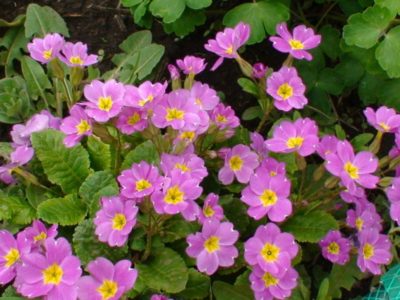

senile cough;- bronchitis;
- pneumonia;
- whooping cough;
- colds;
- runny nose;
- headaches;
- rheumatism;
- sleep and appetite disorders;
- a general decrease in immunity.
Primrose preparations are prohibited for use by people with peptic ulcer diseases of any genesis. and with individual intolerance to primroses. It is strictly forbidden to use such medications during pregnancy, and especially in the first trimester. They can cause the uterus to contract, which often leads to miscarriage.
How and when to plant primrose in the ground
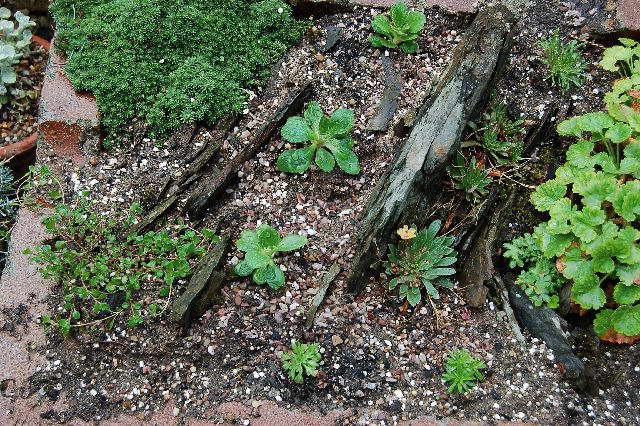

Planting primrose in the ground photo
Prepared primrose seedlings are planted in the second year of life in early spring, as soon as the snow melts and the ground is ripe, or in early autumn. This is usually March-April or September-month. It is good if the place is in partial shade, as primroses love light shading.
- Wells are prepared in advance, according to the size of the pot, in order to maintain the same level of the location of the root collar.
- You can make the hole deeper and put a couple of handfuls of rotted manure or compost on the bottom.
- Set the seedling vertically, carefully sprinkle it with earth, water it abundantly, wetting the soil in the hole through and through.
- From above, the earth is mulched with a layer of humus 2-3 cm.
- The distance between the holes is 25-30 cm.
The primroses remain for a long time to grow in the same place, gradually occupying all the space allotted to them. A carpet of these primroses looks very beautiful. However, after the flowering season, the place will look dull, so it is better to plan the flower bed in advance, planting nearby plants that quickly gain green mass and are able to "disguise" the islet where the primroses have faded.
Reproduction methods
To understand how primrose reproduces, let us remember that this plant belongs to the early flowering "hurry" - ephemeroids. They have a short growing season - until mid-summer they manage not only to bloom, but also to give full-weight seeds. The hottest period of summer the plant is at rest, the second active phase begins closer to autumn. At this time, the growth of the rhizome occurs, there is a storage of substances for the spring vegetation, flower buds are laid for the next season.
Existing breeding methods for perennial primrose are built on the knowledge of these features.
When sowing with seeds, pay attention to the following points.
Boxes with seeds ripen by the middle of summer, remain suitable for reproduction for a very short time - a year, if stored in the cold.
The most friendly seedlings are obtained with podzimny sowing or stratified seeds.
It is useless to collect your seeds from varietal plants and hybrids - they do not retain varietal characteristics, gravitate towards the specific predecessor.
Note! Terry varieties and hybrids of primroses are sterile, they do not set fruit, do not give seeds. This is due to the "technology" of obtaining terry - additional petals are formed from the generative organs - stamens and pistil.
The most effective way to breed primrose is by dividing the bush. It has its own nuances.
The method was laid by nature as an alternative to seed reproduction. A large number of dormant renewal buds are concentrated on the rhizome, which give young rosettes. They are located so tightly that they stick out to the surface of the soil, without dividing they suppress each other.
The best time to transplant is during active growth phases. In primrose, they fall at the beginning of spring and the end of summer.
The more often the bush is divided, the faster young rosettes grow and the flowers become larger.
The fastest way to propagate primrose is by leaf cuttings. What is the peculiarity of primrose cuttings.
As a cutting, not a separate sheet is used, but a rosette. Root formation and survival of the cuttings are high.
A plant obtained by cuttings blooms in its second year.
Let's dwell on each breeding method in more detail.
Sowing with seeds
To obtain new varieties of primrose, seed propagation is the most affordable, although not the easiest way. The time spent on nursing seedlings will pay off with luxurious flowering, and you will receive an elite material for vegetative division.
Primrose is sown in February.For the seeds to sprout, they must go through a cold hardening (stratification) stage, as in nature. The seeds themselves can be stratified by placing them in a damp napkin in the refrigerator for 3-4 weeks, or by placing the container in the cold after sowing.
The substrate for seedlings is light and loose, based on peat. Seeds are sown on a wet soil surface. Some growers advise, instead of watering, to use snow and sow seeds directly on it. So small seeds are more visible, and when melting, the snow will pull them into the soil. The container is covered with a film and sent to the cold for about a month. The limiting subzero temperature is 10⁰ С.
Frozen seeds, after the expiration of the stratification period, are brought into the room. In most primroses, germination occurs in the light (but not in the sun!) At a temperature of 15–18⁰ Celsius. Seedlings are accustomed to fresh air gradually and the film is finally removed from the container only after 1–1.5 weeks. At this time, the seedlings must be protected from direct exposure to sunlight, and the moisture of the substrate must be maintained. They dive into a separate container after the appearance of 1-2 true leaves.
Primroses obtained by propagation from seeds grow slowly. In order not to lose tiny plants, they are recommended to grow in pots until autumn, or even until next spring. They bloom, most often, in the third season.
Note! Some primrose seeds require darkness to germinate. Among them - P. high, candelabra P. Siebold, P. fine-toothed. Auricular primrose rises faster in cold weather (2–5⁰ C).
Reproduction by dividing the bush
Propagation of primrose by dividing a bush is not only a way to get new plants, but also to rejuvenate, heal the old. It is not recommended to keep it in one place for more than 4-5 years. Without dividing, the bush grows old, the leaves and flowers become smaller, the pathogenic flora accumulates in the soil.
The bush intended for dividing is watered abundantly with water, dug out after a couple of hours. The next step is parsing into sockets. The older the plant, the more difficult it is to do this. If young primroses are easily separated by hands, then the old ones have to be cut with a knife. In each part, you need to leave a piece of rhizome, from which new rosettes will climb, roots that are too long can be shortened.
The cuttings are planted in spilled holes filled with humus at a distance of 15–20 cm. After planting, for 7–10 days, while they are taken, water a little every day, but do not pour it so that the rhizome does not rot.
The optimal time for dividing is spring, before flowering, or late summer, first half of September. Autumn plantings for the winter are recommended to be covered.
Pay attention! There are primroses so unpretentious that they can be transplanted even during flowering. Primroses Julia, spring, fine-toothed, tall, Zibolda, etc. have special plasticity and endurance.
Cuttings
Propagation of primrose leaf is used when it is too early to divide the bush. In the second half of summer, several outlets are carefully pinched off and rooted in a cool, shaded place. Auricles, for example, are placed in grooves, on the bottom of which cut sphagnum moss is laid. The roots appear very quickly - after about half a month. After that, the cutting is planted in a small diameter flower pot and kept in a cold greenhouse until spring. Then they are transplanted to a permanent place. Rosettes, rooted directly in the garden, are covered with leaves, lutrasil for the winter.
If, when dividing the bush, pieces of rhizome remain, you can try propagation of primrose by root cuttings. They are planted in a light nutritious substrate to a depth of 2.5–3 cm. With sufficient humidity and the presence of heat, new sockets will hatch from the buds of renewal.
Primula: leaf propagation, rules of care
I have been growing primrose for a long time. Propagated in different ways, of which there are at least 3: dividing the bush, seeds and leafy cuttings (or leaves).I have already used the first two methods, but I have not reproduced the sheets yet. I had one favorite variety to propagate, and the flower had a very weak root system. Therefore, only one method of reproduction appeared to be possible - cuttings. I decided to share my experience and impressions of how to carry out this process correctly, as there are some peculiarities.
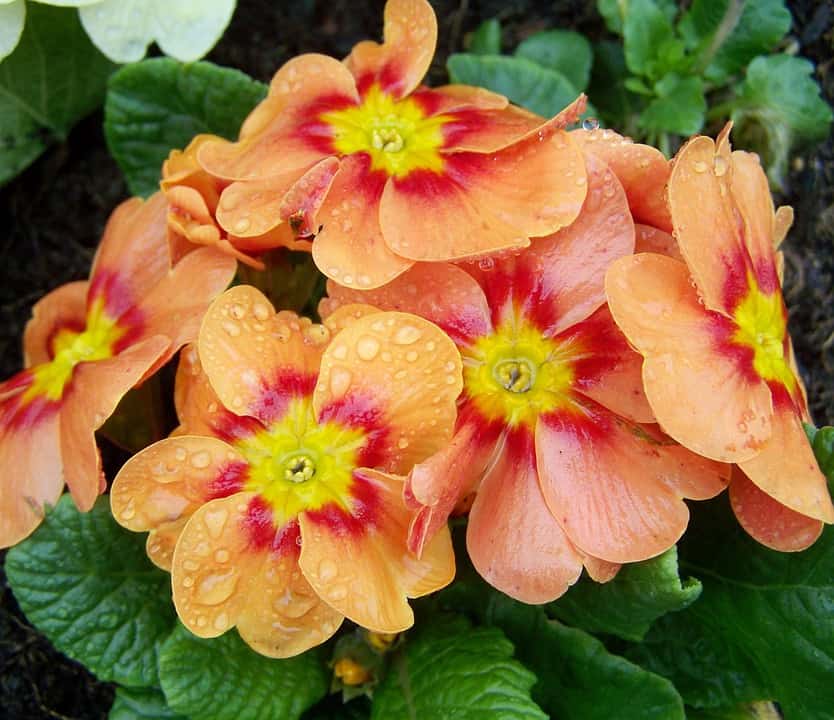

Classification
The classification of primrose is complicated by the multitude of its varieties. At the moment, 7 subgenera are distinguished:
- Sphondylia;
- Auriculastrum;
- Primula;
- Auganthus;
- Carolinella;
- Aleuritia;
- Craibia.
The Horticultural Society of Great Britain proposed a simplified classification, according to which all types of primrose are divided into three groups according to such characteristics as the shape and location of the inflorescences.
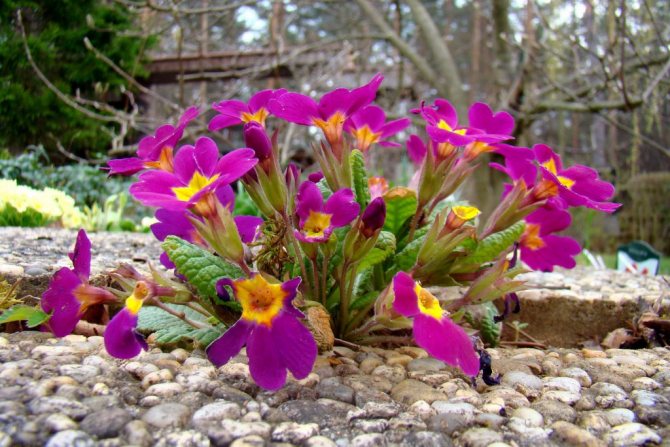

Russian gardeners distinguish the following types of this plant:
- umbrella;
- cushion;
- capitate;
- tiered;
- candelabra;
- bell-shaped.
Among them there are such unpretentious varieties that they can be planted in areas where other plants can hardly survive. A multi-colored carpet of garden primroses will delight you with its beauty every year.
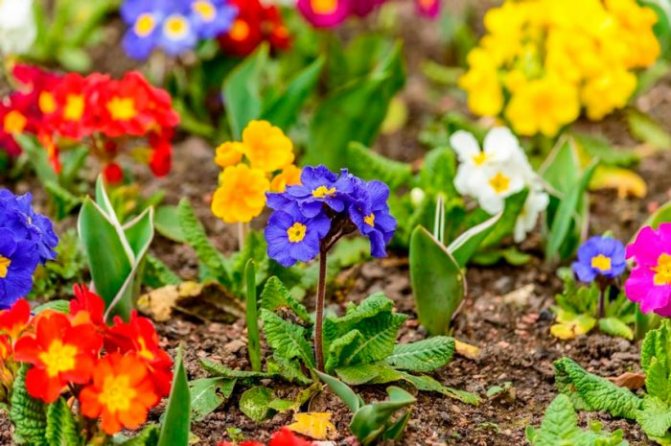

Preparing for winter
In order for the plant to survive the winter safely, it is necessary that it grow in the correct soil, optimal for the given species and timely fertilization.
The soil
Primrose prefers hygroscopic, light and loose soil... It grows best in sandy-clay areas. Mandatory attention is paid to soil drainage. Heavy clay-type soil can be loosened and made lighter by enriching it with sand, manure and sphagnum with perlite.
How to feed?
- Leafy soil, peat and humus work well for the plant. Added during transplant / planting, they give the primroses the nutrition and strength needed for the upcoming period. They also improve the quality of the soil, making it more comfortable.
- Mineral preparations are used from mid-summer to late September. They take the same ones as when caring for a home version of the plant.
- Before covering the primrose for the winter, sprinkle the soil with humus, make a very small layer thickness, and only then lay the plant with a shield of spruce legs or flexible branches of shrubs. Humus, in addition to its nutritional function, also provides an additional heat-preserving and heat-generating factor.
Do you need to prune the leaves?
- Pruning of the leaves of primrose in the fall season is not done. In addition to the fact that this will expose the plant to a more active effect of cold weather, creating a risk of death, it will also suppress the abundance of flowering, reduce the plant's potential for development, enlargement. Dry leaves are harvested only in spring, when the snow melts.
- If the primrose is not frost-resistant and you have to take it into the house during the winter cold, then the leaves are trimmed immediately before removing it from the ground, and the root part is sent for storage in sphagnum.
Next, you need to take several measures to preserve primroses in the winter.:


Flower bed cleaning. Cleansing of plant particles that are potentially harmful for wintering, since under a layer of snow they can rot and provoke putrefaction, be a breeding ground for insect pests. What lies dry on the soil surface in autumn will begin to soak and rot under the snow cap, creating an unhealthy and potentially dangerous environment.- Loosening of the soil is necessary for its aeration, which will reduce the risks of rotting and rotting.
- Moderate watering.
- Before covering the primrose, spill the soil well with water.
- When creating a protective layer of humus, make it so that the top of the rosette remains visible.
- Cover with a lapnik after the temperature drops to -10 degrees.
- The cover layer should be seven to ten centimeters thick.
- Straw can be used instead of spruce legs.
- It is important that the covering material is thoroughly dried.
- If the winters are snowy, then they are not covered with spruce branches, since this function is successfully performed by a snow blanket. The required and optimal cover thickness should be 25-70 cm.
- If necessary, if the cover is thin, you can manually sprinkle primrose with snow, throwing it from other places, forming the desired thickness.
Read more about how to prepare a primrose for wintering here.
How to plant seeds correctly in the fall?
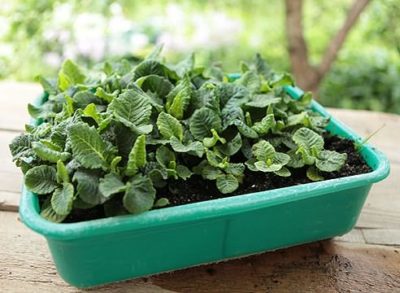

If it is possible to sow primrose seeds immediately after they are harvested, then this should be done in high-quality garden soil in a box. Tara is buried in open beds. The soil is thoroughly watered before sowing. The sowing itself is carried out shallow. Young flowers for the winter are protected with a thick layer of mulch (up to 12 centimeters).
Sowing seeds for the winter is best done in boxes. This should be done when the first night frosts come and the soil begins to freeze. At the bottom of the box, it is necessary to lay a thick layer of drainage. You also need to provide the drawer with a large number of drainage holes. The sowing itself should be carried out as thickly as possible, but the seeds are sown superficially, slightly covering the top with earth.
To protect the flower, it must be covered with any non-woven material or film.... This will save the primrose from snow, weeds and excessive moisture.
Attention: Containers must be placed in a shaded place until spring. Young flowers will need constant watering. Even short-term drought is not permissible for seedlings.

